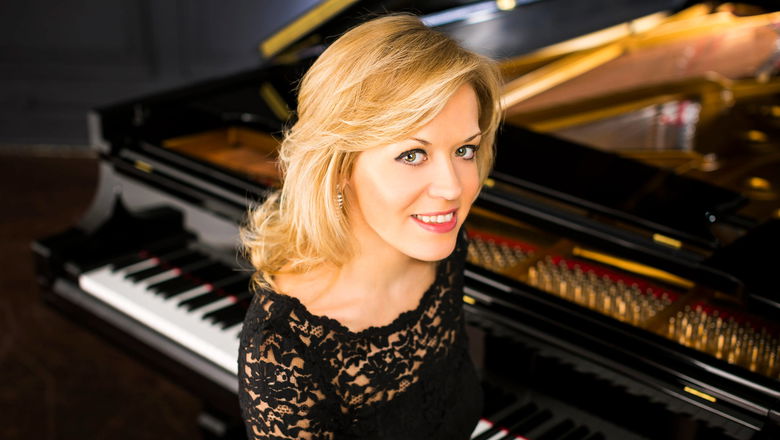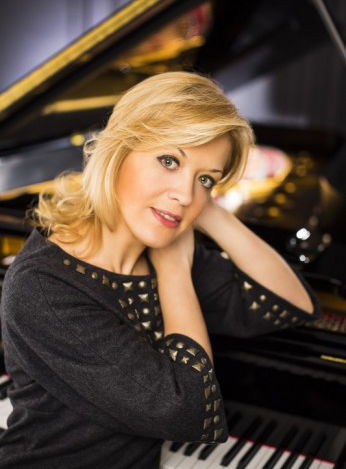At the end of the 18th century, Antonio Salieri was one of Vienna’s most important musicians, serving as the Imperial Court Kapellmeister, and he had nearly 40 operas to his credit, many of which enjoyed success even beyond the monarchy’s capital city. However, Salieri has been wronged by an incorrect interpretation of history; already during the 19th century, he tended to be depicted as Mozart’s chief enemy rather than as an influential and talented composer. In reality, the two composers at least respected each other, and after Mozart’s death Salieri even taught his son, who was far from Salieri’s only important pupil: others who look lessons from him included Franz Schubert, Jan Nepomuk Hummel, and Ludwig van Beethoven (1770–1827), who held Salieri in high esteem. For example, he dedicated his Violin Sonatas, Op. 12, to Salieri, and in 1799 he wrote Ten Variations for piano on a melody from Salieri’s opera Falstaff. The classically transparent composition is framed by Salieri’s playful theme with its sequences at the interval of a second and its sixteenth-note figurations, which Beethoven uses structurally in his variations. Each of the variations is characterised by a different rhythm, and the longest section, the brilliant final variation, clearly anticipates the return of the theme.
In the early 1830s, Robert Schumann (1810–1856) was not far from becoming a successful, sought-after piano virtuoso. As fate would have it, the composer ruined his promising career by the careless use of a device for widening the span between his fingers. However, he did not cease to composer for the piano; in fact, early in his composing career he focused on writing for that instrument almost exclusively. Schumann’s compositions mainly build upon the legacy of Viennese Classicism and Franz Schubert, but in his music Romanticism begins to assume more clearly defined features; he advanced the boundaries of harmony for his day, and he relaxed formal strictures. The cycle Carnaval, Op. 9, is one of his early works, but his style, feel for piano writing, and ability to create unique character portraits are already apparent. Among the 21 pieces, passionate music predominates with louder dynamics, chordal writing, and octave passages. By contrast, there are more restrained pieces like Eusebius and Aveu. Some pieces bear the names of composers, important women in Schumann’s life (Chiarina – a reference to Clara Wieck, and Estrella – a pseudonym for his fiancée at the time), or characters Schumann invented in his writings (Eusebius and Florestan, who represent the opposites of dreamy and impulsive emotions). In the cycle, Schumann also employs cryptograms such as the notes A-Es-C-H (A, E flat, C, B natural) representing the first letters of the composer’s name.
“Why would you want to be a second-rate Ravel when you can be a first-rate Gershwin?” That is supposedly how Maurice Ravel advised George Gershwin (1897–1937) when the young composer asked him for composition lessons. History has proven that Ravel was right: Gershwin became an exceptionally original musician and one of the first to combine the procedures of classical music fully with the specific features of jazz. A skilled pianist, Gershwin also composed music for that instrument including the popular Piano Concerto in F and the Three Preludes (1926). The cycle’s two rhythmic outer movements are full of energetic syncopations and danse rhythms. The middle prelude, the longest of the set, is more lyrical. Winding its way above the bass line is a melody that is suggestive of improvisation. Gershwin himself called the prelude a lullaby. Completely different in character is the Etude No. 7 “Fascinating Rhytm”. The pianist Earl Wild (1915–2010), well known for his piano transcriptions, arranged two volumes of Virtuoso Etudes based on Gershwin’s music. Here, he took Gershwin’s song from the musical Lady, Be Good! and made a very brilliant, sparkling arrangement.
The piano was also the dominant instrument in the music of the last great Romantic composer, Sergei Rachmaninoff (1873–1943). This evening we will be hearing three pieces from different Rachmaninoff piano cycles that mainly share in common their great demands on the performer for technique and musical expression. We begin chronologically with Polichinelle from Rachmaninoff’s first piano cycle with an opus number, the Morceaux de fantaisie. He wrote it in 1892 while still a student at the conservatoire. Polichinelle, named for the commedie dellʼarte character Pulcinella, lets pianists demonstrate their ability both in the dense outer sections and in the more melodic middle part. Just four years later he wrote six diverse piano pieces titled Moments musicaux. The fourth piece, Presto, is the fastest and most virtuosic number in the cycle. The composer writes brilliant figuration for the left hand while theme unwinds itself urgently in thirds in the right hand. Contrasting with those brilliant pieces is the more intimate Étude-tableau, Op. 33, No. 8. Apart from the episodic middle section, the composer is working with a simple melody and contemplative harmonic progressions strikingly highlighted by chromaticism. The title of this 1911 cycle refers to Rachmaninoff’s inspiration from visual stimuli—the word “tableau” means “picture”, and each of the etudes is intended to portray a specific scene.
We also find several cycles and volumes of solo piano music in the works of the earlier Russian Romantic composer Pyotr Ilyich Tchaikovsky (1840–1893). Among the best known are The Seasons and the didactic Album for the Young, but his last work for solo piano, Eighteen Pieces, Op. 72, is also worthy of attention. Tchaikovsky wrote these character pieces in the spring of 1892 while working on his Symphony No. 6. Here, the composer employs his earlier musical language with references to Chopin and Schumann, but we also hear hints of the style that was later developed by Sergei Rachmaninoff. Tchaikovsky composed this work in just 15 days, motivated by his insecure financial situation. The Meditation, Op. 72, No. 5, has become the most popular piece from the set. Tchaikovsky’s songful melodies dominate the composition and are often played in octaves as the music builds in strength. Despite its title, the piece also has some more suspenseful, intense passages, but the coda is quiet with gentle trills in the treble range.
For Alexander Scriabin (1872–1915), the music of Frédéric Chopin was one of the most important sources of inspiration. However, on that basis he soon developed an entirely unique style, thanks to which he enriched the piano literature with very individual works, often of great difficulty. Harmony became the dominant feature of Scriabin’s musical language. He departed ever more remotely from classical tonal procedures, and he instead often used harmony coloristically. He relaxed tonal relationships in part by using chords built from fourths. One example is his “mystic chord”, which uses perfect, augmented, and diminished fourths. Scriabin’s interest in esoterica and mysticism also play a role in Scriabin’s aesthetics. The Etudes, Op. 42 (1903) are examples of the composer’s mature piano compositions and demonstrate his advanced compositional style. While the Etude No. 4 in F sharp major aims at an impressionistic vibrancy of sound, in the dramatic Etude No. 5 in C sharp minor the composer turns to the example of Chopin with passages of evocative figuration.
Mily Alexeyevich Balakirev (1837–1910) was one of the most prominent figures behind the effort to create a Russian musical tradition. With Mussorgsky and Rimsky-Korsakov, Balakirev belonged to the group known as the Mighty Handful, which promoted the idea of nationalistic music and the necessity of a specifically Russian style. As resources, the composers did not just use music from the surroundings of large cities, but also the folklore of more remote areas. This is the case with Islamey, Balakirev’s magnificent piano composition, which was regarded in its day as the most difficult piece in the piano literature. Because of its “exotic” sources of inspiration, the composer even gave it the subtitle “Oriental Fantasy”. Balakirev wrote Islamey in 1869. The thematic basis of the work is a Caucasian dance melody that the composer had heard during his travels. From it, Balakirev builds the lively, highly rhythmic outer parts of the work, which demand exceptional fluency, speed, and precision of touch from the soloist. A contrasting theme in the middle section is supposedly an adaptation of a love song of the Crimean Tatars. Nikolai Rubinstein gave the premiere of Islamey, and it was also in the repertoire of Franz Liszt, the greatest piano virtuoso of the 19th century.



